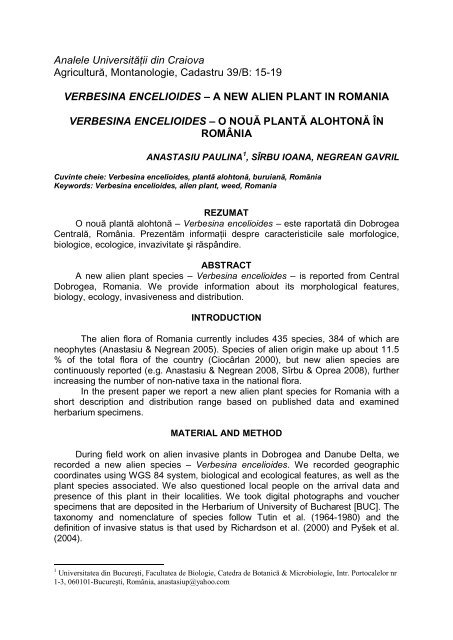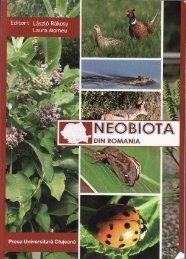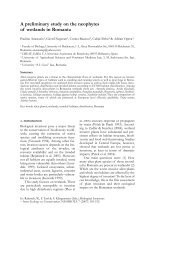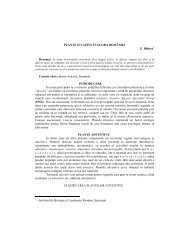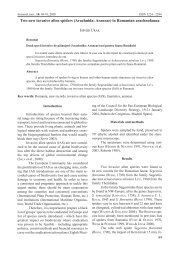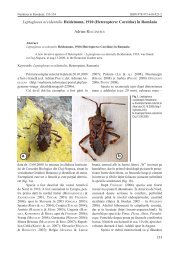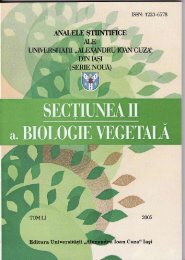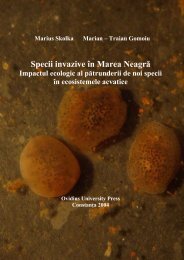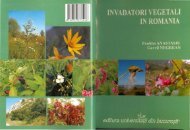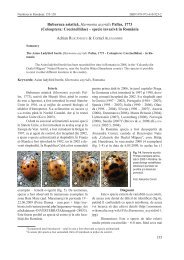15-19 VERBESINA ENCELIOIDES – A NEW ALIEN ... - Specii Invazive
15-19 VERBESINA ENCELIOIDES – A NEW ALIEN ... - Specii Invazive
15-19 VERBESINA ENCELIOIDES – A NEW ALIEN ... - Specii Invazive
You also want an ePaper? Increase the reach of your titles
YUMPU automatically turns print PDFs into web optimized ePapers that Google loves.
Analele Universit��ii din Craiova<br />
Agricultur�, Montanologie, Cadastru 39/B: <strong>15</strong>-<strong>19</strong><br />
<strong>VERBESINA</strong> <strong>ENCELIOIDES</strong> – A <strong>NEW</strong> <strong>ALIEN</strong> PLANT IN ROMANIA<br />
<strong>VERBESINA</strong> <strong>ENCELIOIDES</strong> – O NOU� PLANT� ALOHTON� ÎN<br />
ROMÂNIA<br />
ANASTASIU PAULINA 1 , SÎRBU IOANA, NEGREAN GAVRIL<br />
Cuvinte cheie: Verbesina encelioides, plant� alohton�, buruian�, România<br />
Keywords: Verbesina encelioides, alien plant, weed, Romania<br />
REZUMAT<br />
O nou� plant� alohton� – Verbesina encelioides – este raportat� din Dobrogea<br />
Central�, România. Prezent�m informa�ii despre caracteristicile sale morfologice,<br />
biologice, ecologice, invazivitate �i r�spândire.<br />
ABSTRACT<br />
A new alien plant species – Verbesina encelioides – is reported from Central<br />
Dobrogea, Romania. We provide information about its morphological features,<br />
biology, ecology, invasiveness and distribution.<br />
INTRODUCTION<br />
The alien flora of Romania currently includes 435 species, 384 of which are<br />
neophytes (Anastasiu & Negrean 2005). Species of alien origin make up about 11.5<br />
% of the total flora of the country (Ciocârlan 2000), but new alien species are<br />
continuously reported (e.g. Anastasiu & Negrean 2008, Sîrbu & Oprea 2008), further<br />
increasing the number of non-native taxa in the national flora.<br />
In the present paper we report a new alien plant species for Romania with a<br />
short description and distribution range based on published data and examined<br />
herbarium specimens.<br />
MATERIAL AND METHOD<br />
During field work on alien invasive plants in Dobrogea and Danube Delta, we<br />
recorded a new alien species – Verbesina encelioides. We recorded geographic<br />
coordinates using WGS 84 system, biological and ecological features, as well as the<br />
plant species associated. We also questioned local people on the arrival data and<br />
presence of this plant in their localities. We took digital photographs and voucher<br />
specimens that are deposited in the Herbarium of University of Bucharest [BUC]. The<br />
taxonomy and nomenclature of species follow Tutin et al. (<strong>19</strong>64-<strong>19</strong>80) and the<br />
definition of invasive status is that used by Richardson et al. (2000) and Py�ek et al.<br />
(2004).<br />
1 Universitatea din Bucure�ti, Facultatea de Biologie, Catedra de Botanic� & Microbiologie, Intr. Portocalelor nr<br />
1-3, 060101-Bucure�ti, România, anastasiup@yahoo.com
RESULTS AND DISCUSSIONS<br />
Verbesina encelioides (Cav.) Bentham & Hooker fil. ex A. Gray (Fig. 1)<br />
belongs to Asteraceae family and is native in North America (Hansen <strong>19</strong>76). This<br />
species is an erect, branched annual, about 30-50 cm height, but sometimes<br />
reaching up to 130 cm (Hansen <strong>19</strong>76). Leaves are simple, petiolate, opposite below<br />
and without auricles, alternate above, toothed, with fine white hairs on the underside.<br />
Flowers heads resemble with small sunflowers and can be solitary or in cluster of up<br />
to three heads. We counted up to 42 flower heads per plant. Ligulate florets are 10-<br />
<strong>15</strong>, <strong>15</strong>-25 mm long, yellow to bright-yellow, 3-lobed at apex. Tubular florets are also<br />
yellow. Achenes of ligulate florets are triangled, tuberculate, blackish, 4 × 2 mm,<br />
while achenes of tubular florets are flattened, white-winged, coverd with fine hairs,<br />
blackish, 5-5.5 × 4-4.5 mm (Fig. 2). Every head flowers could has about 100 flattened<br />
achenes and 10 triangled achenes. Verbesina encelioides has no relatives in<br />
Romanian flora, so it can not be confused with other taxa.<br />
Current distribution of Verbesina encelioides includes North America, Central<br />
America, South America, Africa, Asia, Oceania and Europe (EPPO, 2008). For<br />
Europe Hansen (<strong>19</strong>76) reported its presence as doubtful in Germany, Sweden and<br />
Switzerland, while EPPO sources indicate it from Denmark, Spain, UK and Austria<br />
(EPPO 2008).<br />
In Romania we found Verbesina encelioides in few locations from Central<br />
Dobrogea, where it covers large surfaces: Sarighiol de Deal E - 44° 42' N, 028° 31' E,<br />
Sarighiol de Deal SW - 44° 41' N, 028° 29' E (Tulcea County), Râmnicul de Jos - 44°<br />
37' N, 028° 26' E, Gr�dina N - 44° 34' N, 028° 26' E, Cheia N - 44° 31' N, 028° 25' E,<br />
Cheia S - 44° 30' N, 028° 25' E (Constan�a County).<br />
The way of introduction and time of arrival in Romania remain unknown. For<br />
other countries there are reports regarding the introduction of seeds with wool, or as<br />
contaminants in pasture hay or cereal grain (EPPO 2008).<br />
According to locals and our observations, Verbesina encelioides flowers from<br />
September to October, after the abundant rains. The number of achenes produced<br />
per plant can reach 4500. In October, these are dispersed under or nearby the parent<br />
plant, or by winds. We have not data about germination, but according to local people<br />
this plant appears after gathering in the crops and after rain.<br />
Verbesina encelioides can encompass a variety of habitats, temperatures and<br />
elevations (Shluker <strong>19</strong>99). We found it in stubble fields, lucerne fields (Medicago<br />
sativa subsp. sativa) and in ruderal places along roads, up to 245 m altitude. The<br />
area of occurrence is characterized by soil of carbonated chernozem type, drought<br />
and high temperatures during the summer time. Generally, Verbesina encelioides<br />
displays allelopathic effects inhibiting native plants growth (EPPO 2008). However,<br />
we found this species accompanied by: Reseda lutea, Iva xanthifolia, Xanthium<br />
strumarium subsp. italicum, Chenopodium strictum, Ballota nigra subsp. nigra,<br />
Hibiscus trionum, Amaranthus retroflexus, Amaranthus albus, Convolvulus arvensis,<br />
Artemisia absinthium, Cannabis sativa subsp. spontanea, Artemisia vulgaris,<br />
Berteroa incana, Conyza canadensis, Elymus repens s.l., Setaria verticillata, Datura<br />
stramonium, Onopordum acanthium, Cirsium arvense, Hyoscyamus niger, Sinapis<br />
arvensis, Cynodon dactylon.<br />
Verbesina encelioides is reported as weed in many crops from different regions<br />
and countries (EPPO 2008). In Europe this plant it could be an emerging invader<br />
take into account its invasive and aggressive behaviour shown where it has been<br />
introduced (EPPO 2008). In Romania, Verbesina encelioides could be considered as
naturalized, but with a high invasive potential favoured by the dry climate of<br />
Dobrogea region and by the high proportion of areas with disturbed habitats.<br />
Verbesina encelioides is a poisonous plant especially for livestock (EPPO<br />
2008). Its toxicity has been confirmed by local people that call it “iarb� de ti��”, this<br />
meaning poison weed. However, sheep do not consume it.<br />
Although Verbesina encelioides is a beautiful plant, local people does not use it<br />
as ornamental because of its unpleasant smell.<br />
To eradicate this plant we recommend chemical control, as well as mechanical<br />
control for small surfaces. Special measures for quarantine weeds are also required.<br />
CONCLUSIONS<br />
A new alien plant is reported from Romania – Verbesina encelioides – native in<br />
North America. Although its occurrence is presently limited to few locations in Central<br />
Dobrogea, the species seems to be naturalized, but there are conditions to become<br />
invasive.<br />
Acknowledgments:<br />
CNCSIS projects PNII_IDEI 611/2009 grant to Paulina Anastasiu and<br />
PNII_IDEI 273/2007 grant to Dan Cog�lniceanu offered us the opportunity to<br />
discover Verbesina encelioides in Dobrogea, Romania.<br />
BIBLIOGRAPHY<br />
Anastasiu P. & Negrean G., 2005. Alien plants in Romania. Analele �t. Univ. ‘A. I.<br />
Cuza” Ia�i: 51: 87-96.<br />
Anastasiu P. & Negrean G., 2008. New alien plants to Romania • Plante str�ine noi<br />
în România. Analele Univ. din Craiova. Agricultur�, Montanologie, Cadastru.<br />
38/B: 1-10.<br />
Ciocârlan V. 2000. Flora ilustrat� a României - Pteridophyta et Spermatophyta. Edi�ia<br />
a doua rev�zut���i ad�ugit�. Bucure�ti: Edit. Ceres, 1138 pp.<br />
EPPO, 2008. Verbesina encelioides (Asteraceae). Golden crownbeard.<br />
http://www.eppo.org/QUARANTINE/Alert_List/invasive_plants/Verbesina_enceli<br />
oides.htm<br />
Hansen A. <strong>19</strong>76. Verbesina L. In: Tutin et al. (ed.), Flora Europaea, vol. 4.<br />
Cambridge: Cambridge University Press.<br />
Py�ek P., Richardson D.M., Rejmánek M., Webster G.L., Williamson M. &<br />
Kirschner J., 2004. Alien plants in checklists and floras: towards better<br />
communication between taxonomists and ecologists. Taxon 51(1): 131-143.<br />
Richardson D.M., Py�ek P., Rejmánek M., Barbour M.G., Panetta F.D. & West<br />
C.J., 2000. Naturalization and invasion of alien plants: concepts and definitions.<br />
Diversity and Distribution (2000) 6: 93-107.<br />
Shluker A., <strong>19</strong>99. Verbesina encelioides [(Cav.) Bentham & Hooker fil. Ex Gray] ssp.<br />
exauriculata [Robinson & Greenman]. HNIS Report for Verbesina encelioides,<br />
12 pp. http://www.hear.org/hnis/reports/verbesina_encelioides_hnis.pdf<br />
Sîrbu C. & Oprea A., 2008. New Alien Species for the Flora of Romania: Bidens<br />
bipinnata L. (Asteraceae). Turk. J. Bot. 32(2008): 255-258.<br />
Tutin T.G., Heywood V.H., Burges N.A., Moore D.M., Valentine D.H., Walters<br />
S.M. & Webb D.A. (ed.), <strong>19</strong>64-<strong>19</strong>80. Flora Europaea. Vols. 1-5. Cambridge:<br />
Cambridge University Press.
Fig. 1 Verbesina encelioides – habitus (orig.)<br />
Fig. 2 Verbesina encelioides – winged achenes (orig.)


